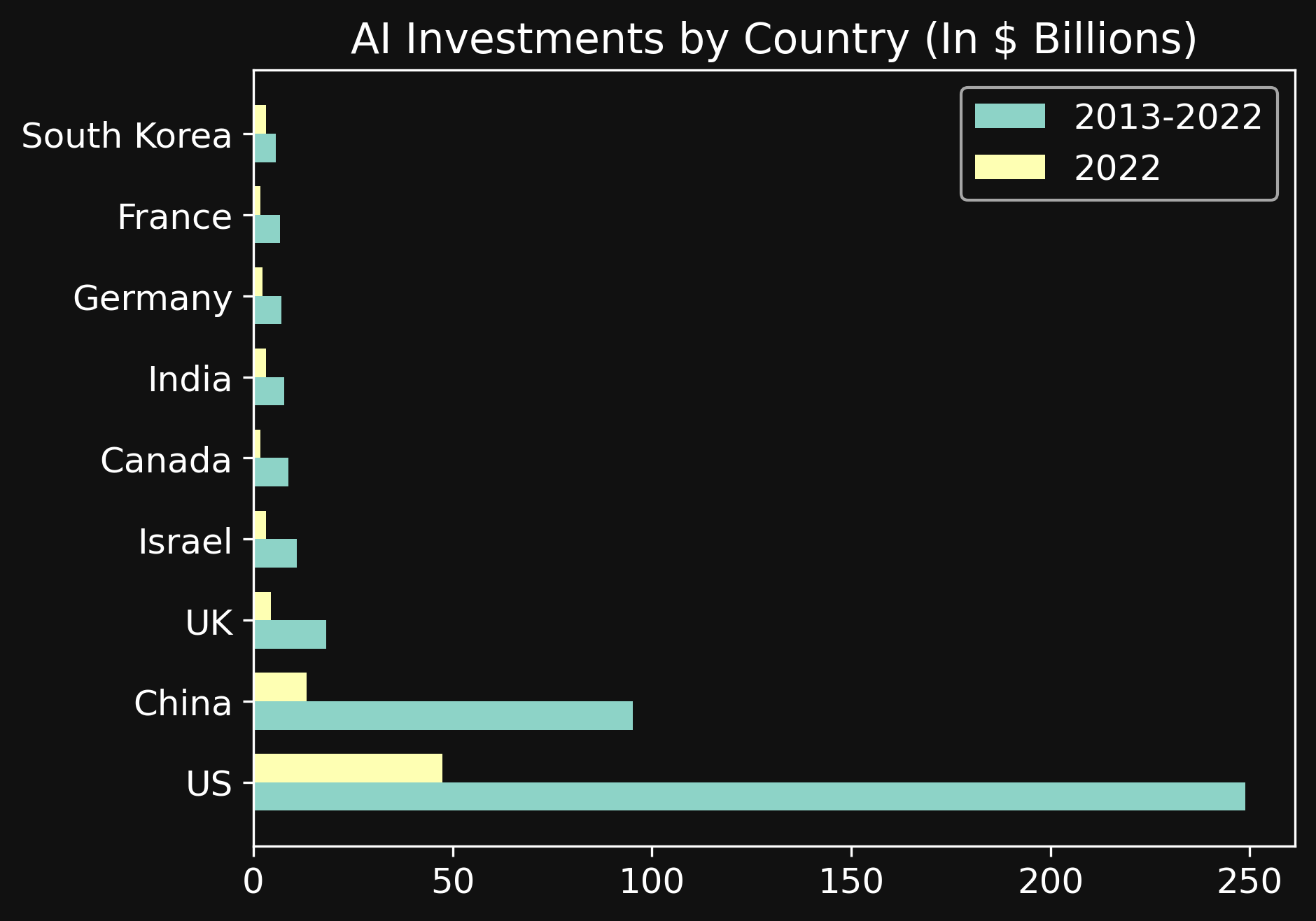Disclaimer: I am still learning about public policy and base this blog post on my current understanding of the topic. I will continue improving this post as I learn more. Any feedback and corrections are welcome.
India is undoubtedly one of the biggest creators and adopters of artificial intelligence.
The AI Index Report by Stanford University estimates $3.24 billion in investments to AI startups in India in 2022. Although this is low compared to the $47.36 billion and $13.41 billion investments in the US and China, respectively, Indian investors have spent almost half the money they have spent in the last decade on AI startups in the previous year.
As governments and tech leaders across the world try to get ahead of the technology, preaching inevitable doom and pushing for urgent legislation, India and its government have been surprisingly pragmatic with their approach to AI.

Although US and China still leads the AI market, India has seen a lot more investment in the last year than it had ever before. Data source: The AI Index Report
On April 2023, the Ministry of Electronics and Information Technology of the Government of India clarified its position to not introduce new legislation to curb AI growth. I would not be surprised to see more investment in AI and related tech in 2023 because of this policy stance.
But “regulate” and “don’t regulate” aren’t the only choices for the government, although they are pronounced. So what else can the government do?
In this article, I will try to answer this question with eight possible approaches with increasing levels of state intervention. Let’s start with the least effortless and intrusive approach, which is to
Do Nothing
Doing nothing has its merits! The AI landscape is still a bit like the wild west, constantly changing and evolving. By leaving it alone, the government can allow the system to develop organically.
But inaction also has consequences. A lack of accountability could lead to potential misuse of AI and put us on a path to the preached doom.
It will be up to the government and policymakers to decide if the benefits of inaction outweigh the costs. However, India left this station long ago and is more proactive with its approach.
Engage in Rhetoric
This is a slightly more intervening activity than doing nothing.
The Indian government has been actively engaged in AI for some time by setting up bodies like The National AI Portal of India (INDIAai). The body does not actively do anything to intervene in AI growth. Still, it hints that AI is an important technology, and the country needs to prepare to tackle future challenges it poses.
Discussions in the parliament on AI regulation and using AI for the public good can also be seen as engagement by the government. With AI potentially altering the course of human history, being in the loop with such discussions might be a bare minimum action in any government.
Nudge Change
NITI Aayog, the government’s public policy think tank, has published multiple strategy guides on how AI can be used in the country. These are just guidelines and not concrete legislation for using AI.
Such initiatives can nudge creators and users of AI in the country to act in a certain way without the government intervening too much. For example, in a set of guidelines titled “Responsible AI,” the policymakers suggest how AI should be used with the country’s existing public infrastructure with responsibility. AI creators can choose to adhere to these guidelines.
Umpire
Just like an umpire ensures a fair game, the government will ensure a fair market environment by setting regulations and coercing all players to follow these regulations.
In a recent US Senate hearing, Sam Altman, the CEO of OpenAI, Christina Montgomery, IBM’s chief privacy and trust officer, and Gary Marcus, a well-known professor, and an AI critic, unanimously agreed with the lawmakers that AI should be regulated. Although this seems like a fair idea, this could lead to drastic outcomes like regulatory capture, where large companies use the regulations in their favor to build a market monopoly.
India’s decision to not introduce new regulations is in stark contrast to what the US and EU are leaning on currently and has the potential to build the country into a leading AI economy.
Marginally Incentivize
The government can also choose to incentivize private players to work on AI through tax reductions or special economic zones. These are small changes to alter the behavior of private players to encourage them to work in AI.
The government can also start adopting AI projects like the new AI traffic camera system in Kerala, which could result in more companies building AI products. For the government, this would mean they can delegate the responsibility to acquire and apply knowledge about AI to these private players instead of trying to build this capacity on their own.
Drastically Change Incentives
ChatGPT was banned in Italy earlier this year, stating privacy concerns. The Indian government can follow the Italian way and similarly ban AI tools (we know the Indian government likes to ban software).
But banning something is always a wrong solution, especially when it comes to software. There will still be a lot of ways (like using VPNs) for Italians to access ChatGPT, and in reality, the government will not have any reliable way to enforce this ban.
An AI ban in India could result in companies moving out of India to set up shop in countries with better policies, hurting India in the long run.
The government can also choose to go the other way and provide significant incentives like funding and low tax rates to bring in more companies to work on AI. The tricky part is to design incentives that effectively change behavior.
An interesting thing here was that the ban in Italy forced OpenAI to improve the privacy measures in ChatGPT. So the question of what works and doesn’t isn’t completely obvious.
Change/Reassign Ownership
The government can take over and nationalize AI companies in the country as it did with banks.
This might be the worst thing the government can do and can take us back to a Soviet dystopia. Although the central and state governments in the country like public sector undertaking, I highly doubt it would do something similar with AI.
A possibility of this happening is in countries like China or North Korea, where the government might take full or partial ownership of AI companies.
DIY
Finally, the government can choose to build AIs of its own. As AI becomes a tool for dominance in international relations, developing AIs in areas like defense might be a good strategy for India.
Many technologies we use today have origins within government institutions, particularly the military. Since AI is already public and changing rapidly, the government might have to assess whether it can justify spending resources to build DIY AIs that could easily be inferior to new AIs in the market.
But I can see the government trying DIY on a smaller scale. An interactive AI that can answer people’s questions about the government could be a relatively small effort and might be the type of AIs that the government would build itself in the future.
What Should the Government Do?
Deciding what to do fundamentally boils down to two things: the capacity of the state and the extent to which the state wants to intervene.
India currently has a low capacity in this area, and its direction on policy actions is towards the less intrusive side of the spectrum. This is the right approach for the country and would result in the best possible outcomes.
But the AI landscape is constantly changing, and India’s policy stances should change with it. Having more technologists engage and work in policy matters and active fostering from the government could help the country emerge as a leader in this AI revolution.
Related Posts
- One Nation, One Subscription, Many Problems
- AI Traffic Cameras Were Always a Bad Idea
- An Even Playing Field
Thank you for reading "Eight Things the Indian Government Can Do about AI."
Subscribe via email or RSS feed to be the first to receive my content.
If you liked this post, check out my featured posts or learn more about me.
